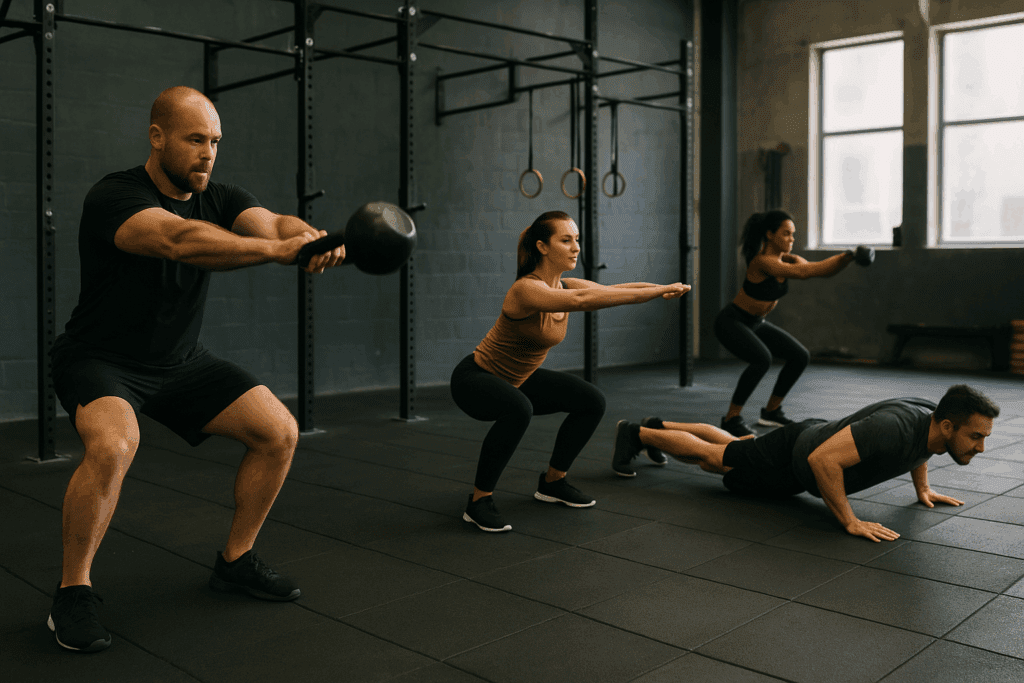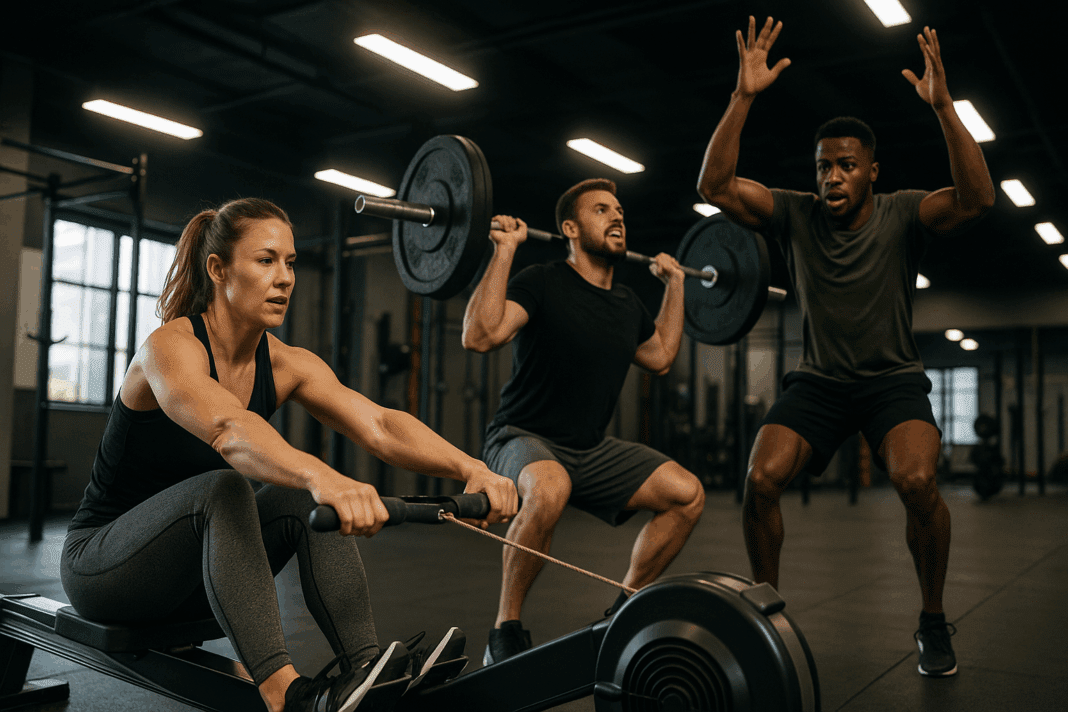Introduction: The Intersection of Fat Loss and Endurance Training
The modern gym-goer is not merely in pursuit of aesthetic transformations; increasingly, individuals are seeking a synergistic improvement in body composition, cardiovascular health, and athletic performance. This dual objective—fat loss coupled with endurance enhancement—forms the backbone of many contemporary fitness regimens. But what is a good exercise to burn fat that also improves stamina? The answer lies in a combination of science-backed training modalities that simultaneously increase metabolic output and improve muscular and cardiovascular endurance.
This article explores the most effective gym exercises to lose weight, with a deep dive into those that offer high fat-burning potential while also strengthening the body’s ability to perform for longer durations. Whether you’re a seasoned athlete or someone starting their weight loss journey, understanding what workouts burn the most fat while also fostering endurance can dramatically improve the efficiency of your gym sessions. Integrating these strategies not only accelerates fat loss but lays a foundation for long-term wellness and performance enhancement.
You may also like: How to Increase Stamina and Endurance Naturally: Smart Training Tips and Nutrition Habits That Support Cardiovascular Fitness

High-Intensity Interval Training (HIIT): Maximizing Fat Burn in Minimal Time
High-Intensity Interval Training (HIIT) has earned its reputation as one of the most efficient and powerful fat-burning exercises at the gym. By alternating between periods of intense effort and brief recovery, HIIT creates an environment where the body is pushed to its metabolic limit. This process stimulates Excess Post-exercise Oxygen Consumption (EPOC), which means your body continues to burn calories long after the workout has ended.
A key reason why HIIT is considered among the best workouts to lose weight fast is its ability to activate both aerobic and anaerobic energy systems. This dual activation helps improve cardiovascular function while rapidly depleting glycogen stores and promoting fat oxidation. HIIT protocols like cycling sprints, treadmill intervals, and rowing bursts can all be tailored to suit varying fitness levels, making them highly adaptable. Moreover, studies show that HIIT improves VO2 max, an essential marker for endurance athletes.
In terms of practicality, HIIT routines can be completed in as little as 20 to 30 minutes, making them ideal for busy professionals seeking good workouts to lose weight fast without compromising performance. The short, explosive nature of HIIT sessions also builds mental resilience and physical toughness—qualities essential for sustained athletic performance. Thus, HIIT stands out not just as a fat loss exercise in the gym but as a holistic training method.
Steady-State Cardio: The Underestimated Fat Loss Ally
While HIIT often dominates fitness headlines, steady-state cardio remains a cornerstone of effective fat loss strategies. Contrary to misconceptions that it is outdated or less effective, steady-state cardio offers unique advantages, especially when integrated into a periodized training plan. Activities like jogging on the treadmill, cycling at a moderate pace, or maintaining a steady row on the ergometer are excellent gym exercises for weight loss that emphasize sustainability over intensity.
These longer-duration sessions encourage the body to rely primarily on fat as its fuel source, which makes them highly effective for those targeting long-term fat reduction. Furthermore, steady-state cardio enhances mitochondrial density and capillary growth, both of which are crucial for endurance performance. Over time, consistent aerobic conditioning increases the body’s efficiency at mobilizing and oxidizing fat stores, creating an optimal internal environment for weight management.
The beauty of steady-state cardio lies in its accessibility and low impact. It is especially suitable for individuals who may not yet have the capacity for high-intensity efforts. When performed consistently and paired with a healthy diet, this approach becomes one of the best workouts to lose fat in a sustainable, injury-reducing manner. Combining steady-state cardio with strength training also improves muscular endurance, further enhancing fat-burning potential over time.

Strength Training: Muscle as a Metabolic Engine
Strength training is often undervalued in discussions about fat loss, yet it plays a critical role in both calorie expenditure and metabolic function. Lifting weights promotes muscle hypertrophy, and because muscle is metabolically active tissue, it increases your basal metabolic rate (BMR). This means your body burns more calories even at rest, making strength training one of the most underrated gym workouts to reduce weight and maintain fat loss over time.
Compound lifts such as squats, deadlifts, bench presses, and rows are particularly effective. These multi-joint movements recruit several muscle groups simultaneously, leading to greater energy expenditure during and after workouts. Moreover, strength training improves insulin sensitivity and glucose metabolism, both of which are essential for maintaining a healthy body composition. For individuals asking what workouts burn the most fat, incorporating resistance exercises into their routine provides a decisive answer.
Another benefit is the preservation of lean mass during caloric deficits. When trying to lose fat, there’s a risk of losing muscle as well—something that can be mitigated through consistent resistance training. Not only does this maintain metabolic function, but it ensures the body remains strong, agile, and capable of performing demanding endurance activities. In short, muscle is a fat-burning ally, and strength training is the key to unlocking its potential.

Circuit Training: Blending Cardio and Strength for Total Conditioning
Circuit training combines elements of resistance work and cardiovascular conditioning into a seamless workout format that keeps the heart rate elevated while targeting different muscle groups. This training modality is particularly effective for those seeking good workouts to lose fat while also building muscular endurance. By moving from one exercise to the next with minimal rest, circuit training challenges both the aerobic and anaerobic systems, making it a top contender for those searching for fat-burning exercises at the gym.
An effective circuit might include bodyweight squats, push-ups, kettlebell swings, battle ropes, and medicine ball slams, repeated in succession. This approach not only torches calories during the session but also contributes to the afterburn effect—much like HIIT. Unlike traditional cardio, circuit training also improves functional strength, coordination, and movement efficiency, all of which are essential for performance enhancement in athletic and daily contexts.
What distinguishes circuit training from other gym exercises for weight loss is its versatility. It can be tailored to different fitness levels, time constraints, and equipment availability. Because it blends cardio and strength seamlessly, circuit training serves as both a good workout to lose weight fast and a long-term strategy for improving endurance and overall fitness capacity.
Rowing and SkiErg Workouts: Full-Body Engagement for Maximum Burn
Among the most comprehensive machines found in modern gyms, the rowing ergometer and the SkiErg offer full-body workouts that elevate heart rate while engaging nearly every major muscle group. These machines exemplify what workouts burn the most fat, as they combine resistance with rhythmic cardiovascular movement. A high-intensity rowing or SkiErg session can rapidly elevate oxygen consumption, driving fat oxidation and caloric expenditure.
Rowing, for instance, demands coordination between the legs, core, back, and arms. This creates a compound movement pattern that significantly increases energy demands, particularly when performed in sprint intervals. Similarly, the SkiErg mimics the motion of Nordic skiing, relying heavily on the lats, triceps, and core, while also activating the lower body for stability. The result is a high-intensity, low-impact workout that promotes both fat loss and endurance.
What makes these workouts particularly effective is their scalability. Whether used for intense intervals or longer endurance sessions, both machines offer varied resistance and pacing options. They are perfect for those seeking a gym workout to reduce weight that is efficient, joint-friendly, and time-effective. Additionally, they serve as excellent cross-training tools for runners, cyclists, and other endurance athletes.

Group Fitness Classes: Motivation Meets Metabolism
For many individuals, the social and structured environment of group fitness classes serves as an effective motivator and accountability mechanism. Classes such as spin, boot camps, and CrossFit-style sessions have gained immense popularity for their ability to deliver fat-burning results while fostering community support. These sessions typically blend high-intensity cardio with strength-based movements, making them ideal gym exercises for weight loss.
Group fitness environments often utilize a time-based format, such as AMRAP (as many rounds as possible) or EMOM (every minute on the minute), which promotes consistent effort and maximizes calorie burn. The shared energy in a class setting often inspires participants to push harder than they might alone, resulting in a more effective workout. Furthermore, these classes frequently rotate routines, keeping both the mind and body engaged.
One of the strongest arguments for group fitness lies in its built-in progression and scalability. Instructors can offer modifications for beginners while challenging advanced members with weighted options or speed increases. This flexibility makes group fitness an accessible and enjoyable fat loss exercise in the gym that simultaneously builds cardiovascular endurance, strength, and mental grit.

Treadmill and Incline Workouts: Simplicity with Strategic Intensity
Treadmills remain a staple in gyms for good reason. They offer controlled environments to implement structured running or walking programs that are highly effective for weight loss and endurance building. Walking or jogging at a steady pace on an incline is a deceptively simple strategy that can significantly elevate heart rate and fat oxidation, especially for those new to fitness.
When used with purpose, the treadmill becomes a powerful tool for fat loss. Sprint intervals on flat surfaces can replicate HIIT benefits, while long incline walks serve as low-impact, high-output sessions ideal for preserving joint health. This adaptability makes treadmill routines among the best workouts to lose fat for a wide range of individuals.
By manipulating incline and speed, users can progressively challenge themselves and avoid plateaus. Moreover, consistent treadmill workouts improve stride efficiency, cardiovascular capacity, and leg endurance, all of which translate to improved athletic performance outside the gym. These benefits underscore the treadmill’s role not just in gym exercises to lose weight but also in broader performance enhancement goals.

Battle Ropes and Functional Tools: Engaging Core and Conditioning
Functional tools such as battle ropes, sleds, kettlebells, and sandbags are now integral to gym-based fat loss protocols. These implements allow for dynamic, compound movements that engage the core, stimulate large muscle groups, and raise the heart rate rapidly. Using these tools effectively answers the question of what is a good exercise to burn fat with intensity and variety.
Battle ropes, in particular, are deceptively challenging. They offer high-frequency muscular contractions while keeping the heart rate elevated, making them one of the most effective fat-burning exercises at the gym. Whether performed in intervals or as part of a circuit, battle rope drills can be adapted to match any fitness level.
Kettlebell swings, sled pushes, and sandbag cleans similarly offer full-body engagement that promotes both strength and metabolic conditioning. These workouts not only accelerate fat loss but enhance functional movement patterns and muscular coordination. By incorporating functional tools into your routine, you diversify your training while ensuring that every session contributes to endurance gains and weight loss alike.
Frequently Asked Questions: Fat-Burning Gym Workouts and Endurance Training
1. How often should I change my fat loss workout routine for optimal results?
To maximize results, it’s important to introduce variety into your routine every 4 to 6 weeks. This prevents plateaus, keeps your body adapting, and ensures you’re hitting different muscle groups and energy systems. While gym exercises for weight loss like HIIT and strength circuits are effective, doing the same ones repeatedly can lead to diminishing returns. By changing your approach—switching from resistance-based circuits to rowing intervals or alternating your rep ranges in weightlifting—you’ll maintain both metabolic stimulation and motivation. When selecting good workouts to lose weight fast, opt for progressive challenges rather than dramatic overhauls to maintain consistency and prevent injury.
2. Can you lose fat with just strength training, or do you need cardio as well?
Strength training alone can lead to fat loss, especially when combined with proper nutrition, but adding cardiovascular work can enhance results. Weightlifting builds lean muscle, which increases your resting metabolic rate, making it one of the best workouts to lose fat long-term. However, incorporating fat burning exercises at the gym—like rowing, incline treadmill walks, or spin intervals—can boost daily calorie expenditure and heart health. A hybrid approach allows for maximum caloric output and muscle retention. The best workout to lose weight fast often includes both modalities, helping to accelerate progress and maintain endurance.
3. What role does rest and recovery play in gym workouts aimed at fat loss?
Recovery is an often-overlooked pillar of successful weight loss and endurance training. Overtraining can lead to hormonal imbalances, elevated cortisol, and muscle breakdown, all of which impair fat-burning potential. Rest days allow your muscles to repair and grow, thereby increasing your capacity for future sessions. Even the best workout to lose fat will be counterproductive if performed without sufficient rest. Structuring your gym workout to reduce weight with recovery in mind—such as alternating HIIT days with active recovery or yoga—creates a sustainable routine that supports both fat loss and overall health.
4. Are fasted workouts better for fat loss than fed workouts?
Fasted workouts can enhance fat oxidation in some individuals, particularly during low to moderate intensity sessions. However, they are not inherently superior to fed workouts in terms of total fat loss over time. What workouts burn the most fat is more dependent on total energy balance and effort, rather than whether you’ve eaten beforehand. For high-intensity efforts or weightlifting, training in a fed state often improves performance and reduces injury risk. If you’re doing gym exercises to lose weight early in the morning, experiment with light pre-workout nutrition and monitor your energy levels and results.
5. How can I measure whether a workout is effectively burning fat?
Rather than relying solely on the scale, monitor performance metrics like endurance improvements, strength gains, and how your clothes fit. A workout’s fat-burning effectiveness is reflected in both visual and physiological changes—lower body fat percentage, improved cardiovascular capacity, and muscle definition. For example, good workouts to lose fat should leave you feeling both fatigued and energized—a sign of metabolic activation. Tools like heart rate monitors and fitness trackers can help ensure you’re training in an optimal zone. Long-term consistency with gym exercises for weight loss matters more than short-term intensity alone.
6. Can beginners safely do high-intensity fat loss workouts at the gym?
Yes, but only with proper progression and supervision. While HIIT ranks high among fat loss exercise in gym environments, beginners should build a foundation first with low-impact movements and basic strength work. Jumping straight into the most intense fat burning exercises at the gym can increase injury risk and demotivation. Instead, start with scaled intervals or machine-based cardio, gradually increasing complexity and duration. This approach ensures that your body adapts gradually and you’re able to sustain good workouts to lose weight fast without burnout.
7. Do certain exercises target fat in specific areas like belly or thighs?
Spot reduction is a widely misunderstood concept. While fat burning exercises at the gym can tone underlying muscle, they do not selectively remove fat from targeted areas. Overall fat loss occurs through a consistent caloric deficit, and genetics largely dictate where fat is lost first. However, compound movements like deadlifts, squats, and rowing—which are part of many gym workouts to reduce weight—help sculpt the entire body. Combining strength with cardio will ensure a more even and noticeable reduction in body fat.
8. What’s the most overlooked factor when trying to lose fat through gym workouts?
Sleep quality and stress management are frequently underestimated. These two elements have a direct impact on hormonal regulation—particularly cortisol, insulin, and leptin—which can influence how your body stores or burns fat. You could follow the best workout to lose weight fast, but if you’re consistently underslept or stressed, your results may stall. Mental fatigue also affects gym performance, making it harder to complete high-effort sessions. To truly optimize gym exercises for weight loss, ensure that recovery strategies and mental well-being are part of your routine.
9. How do endurance improvements relate to fat loss outcomes?
Improved endurance allows you to sustain effort longer and recover faster, which in turn enhances the quality and volume of your workouts. This means you can engage more frequently in fat loss exercise in gym sessions without overtraining. Aerobic efficiency also helps shift your body into fat-burning mode more effectively during moderate-intensity activities. When endurance improves, so does the body’s ability to utilize fat as a primary fuel source. So while some focus solely on high-effort bursts, developing stamina can significantly complement what is a good exercise to burn fat over time.
10. How can I stay consistent with fat loss training when motivation dips?
Motivation often fluctuates, so building habits that reduce friction is key. Scheduling workouts like appointments, training with a partner, or joining a group class can provide accountability. Changing your environment—trying new gym equipment or alternating between strength and cardio-focused days—can also help reignite enthusiasm. When you’re clear on your goals and tracking small wins, even the most challenging fat burning exercises at the gym become more manageable. Ultimately, good workouts to lose fat become sustainable when they align with your lifestyle and are enjoyable enough to keep doing even on tough days.
Conclusion: Building a Sustainable Fat Loss and Performance Plan
Achieving meaningful, lasting fat loss requires more than sporadic effort or chasing the latest fitness trend. It involves strategic planning, disciplined execution, and a clear understanding of how different types of exercise influence metabolism, muscle function, and cardiovascular health. As this article has shown, the best workout to lose fat is often one that combines multiple modalities—HIIT, strength training, circuit formats, and steady-state cardio—to create a balanced, performance-driven program.
For those seeking a gym workout to reduce weight effectively while also building endurance, the key is to prioritize consistency, progression, and variety. There is no single magic formula; rather, success lies in integrating proven principles across your weekly routine. Emphasizing good workouts to lose fat that also enhance endurance ensures that your efforts yield both short-term results and long-term health benefits.
In the end, understanding what workouts burn the most fat while supporting overall performance empowers you to train smarter, not just harder. Whether you’re rowing through high-intensity intervals, lifting for strength, or climbing an incline on the treadmill, each movement contributes to a larger goal: a leaner, stronger, more resilient body. By embracing expert-backed, evidence-based strategies, you not only lose fat—you build the foundation for a lifetime of wellness and performance excellence.
Was this article helpful? Don’t let it stop with you. Share it right now with someone who needs to see it—whether it’s a friend, a colleague, or your whole network. And if staying ahead on this topic matters to you, subscribe to this publication for the most up-to-date information. You’ll get the latest insights delivered straight to you—no searching, no missing out.
Further Reading:
Best Exercises for Weight Loss

